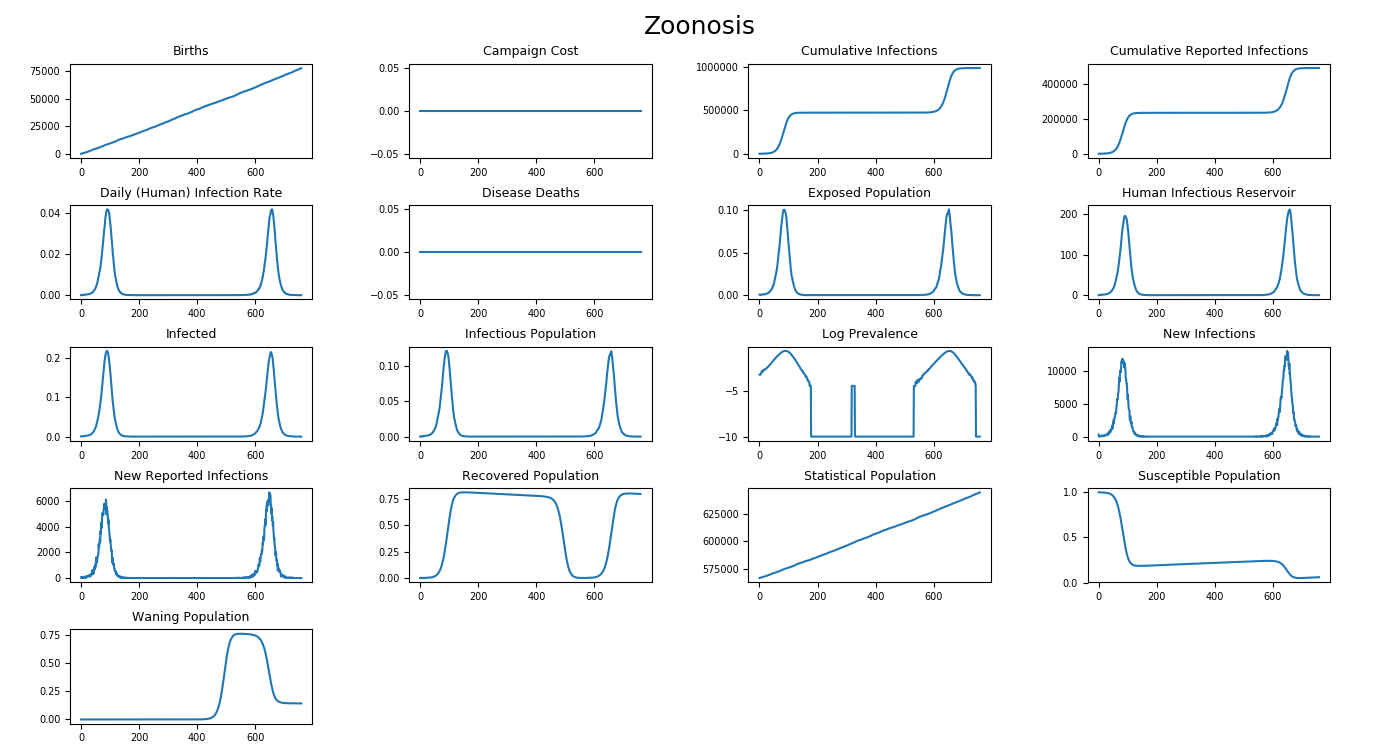Disease outbreaks, reservoirs, and endemicity¶
To configure disease outbreaks in EMOD simulations, you have a few different options. Generally, you will configure an outbreak event to occur at some point during the simulation. For zoonotic diseases, you can also introduce the disease through an animal reservoir.
Outbreak events¶
Somewhat counter-intuitively, disease outbreaks are configured as “interventions” in the campaign file. While the demographics and configuration files specify consistent qualities of the population or disease, the campaign file is organized into events that occur during the course of the simulation. Most of these events trigger disease interventions such as vaccinations and diagnostic tests, but the outbreak is included here as well. Like other interventions, outbreaks are nested within event coordinators and events, which control when, where, and within which demographic the outbreak occurs. For more information, see Creating campaigns.
The two available classes for including a disease outbreak are:
- OutbreakIndividual
This intervention infects existing individuals with a specified disease. You can configure the outbreak to occur in individuals that meet certain criteria, such as being high risk.
- Outbreak
This intervention adds new infected individuals to a node or infects existing individuals. You cannot specify the demographics of these individuals because the outbreak is at the node level.
Because of the ability to target outbreaks to specific individuals, OutbreakIndividual is much more commonly used. However, you can use either type of outbreak for the scenarios described below.
Emergent outbreak¶
In a population where the disease is not endemic, you will generally include one outbreak in the campaign file. If the population is naive (no immunity), the disease will likely spread. If the population has immunity, it may not. Immunity may be due to vaccination or, if the disease was recently endemic, prior infection.
For an example of the effect of vaccination on herd immunity and the spread of an outbreak, see Creating campaigns.
Endemic disease¶
If the disease is endemic to a region, outbreaks can be periodically repeated to simulate regular occurrences of the disease in the population. There will likely be some level of immunity within the population when a disease is endemic.
Alternatively, you can run a simulation for a period of time until the disease dynamics reach a steady state and disregard simulation output prior to that point. This is known as simulation burn-in, a modeling concept borrowed from the electronics industry where the first items produced by a manufacturing process are discarded. EMOD enables you to then serialize the population state at this point so you can reload in subsequent simulations to analyze the effect of interventions on an endemic disease. See Simulation setup for serialization parameters.
Infectivity reservoirs¶
You can also introduce outbreaks through infectivity reservoirs; for example, zoonotic diseases may have a background animal reservoir that continuously exposes humans to infection. Zoonotic diseases are of particular interest because typically they have not previously been in the human population, making the whole population susceptible.
To configure a simulation with an infectivity reservoir, you must enable the configuration parameter Enable_Infectivity_Reservoir and configure the demographics parameter InfectivityReservoirSize. You may also use and configure the demographics parameters InfectivityReservoirStartTime and InfectivityReservoirEndTime.
The rate of reservoir-to-human transmission is configured with the parameter InfectivityReservoirSize and human-to-human transmission by the Infectivity and transmission parameters. These values can be adjusted to shift the disease from a low rate of primary zoonotic infection with substantial secondary human transmission to a high zoonosis rate with low human transmission. This changes the fraction of cases that are primary zoonotic infections.
The following graphs show the inset chart and charts for all channels in an outbreak of a zoonotic disease. To run this example simulation, see the Generic/Zoonosis scenario in the downloadable EMOD scenarios zip file. Review the README files there for more information.
After the initial outbreak, there are no additional imported cases set in the campaign file. However, there are additional introductions from the animal reservoir, as shown in the log prevalence chart.

Figure 1: Zoonotic disease outbreak and animal reservoir¶

Figure 2: All output channels showing re-seeding caused by zoonosis and waning immunity¶